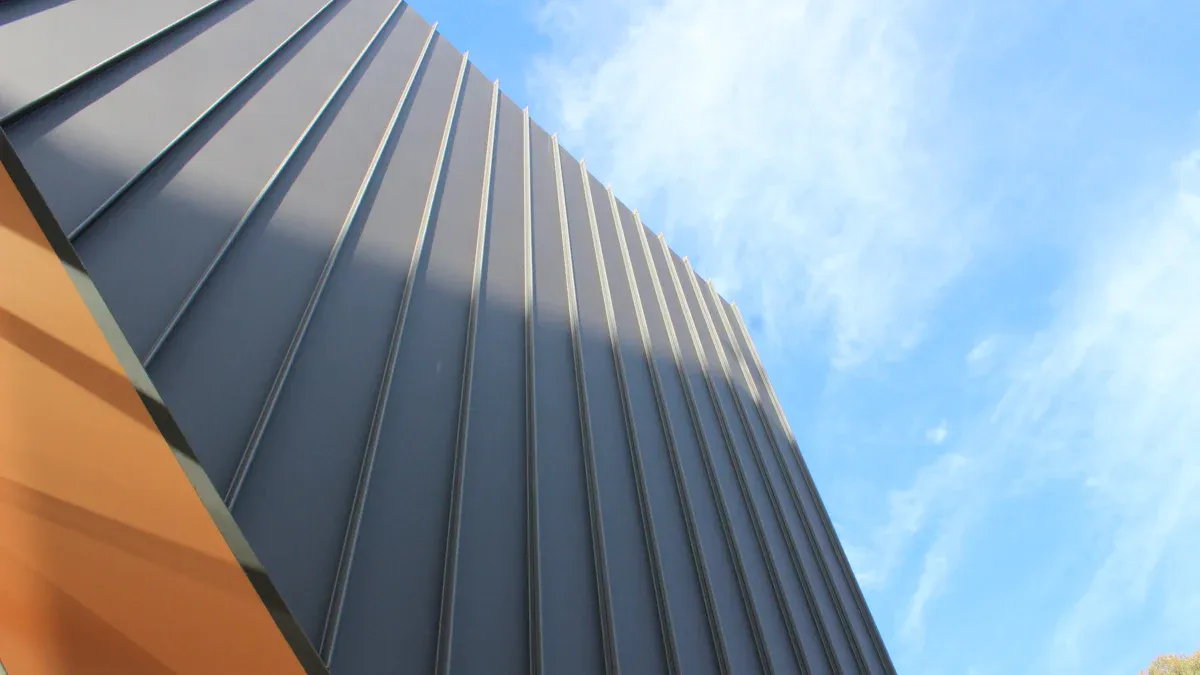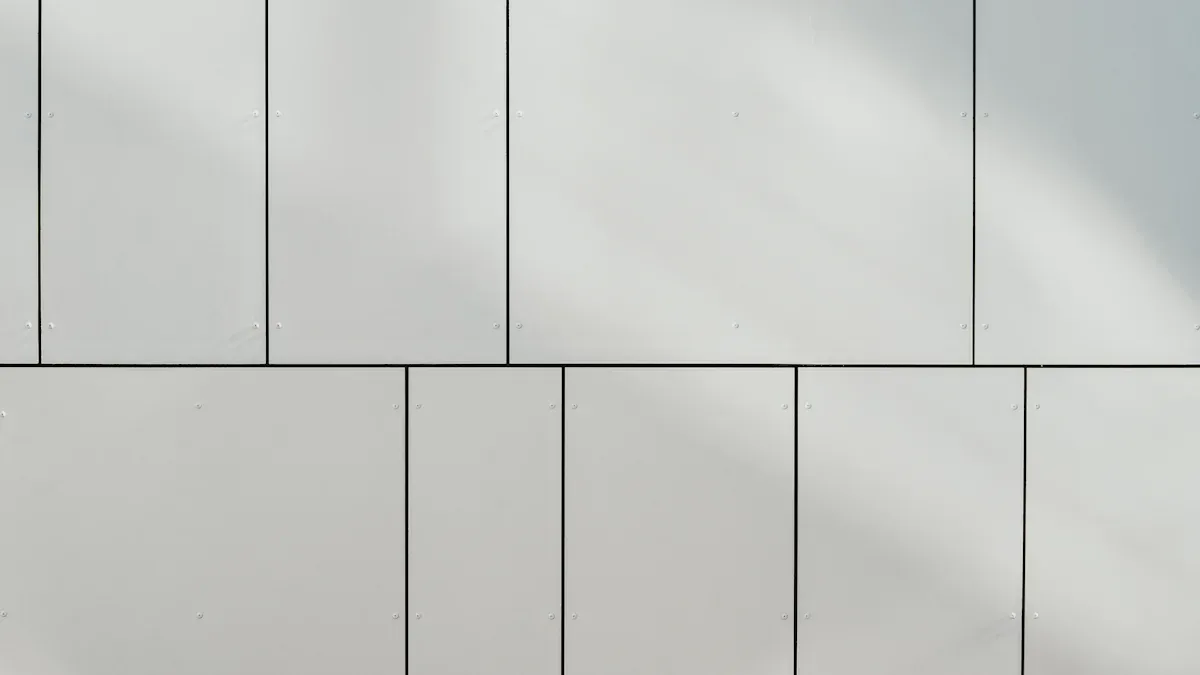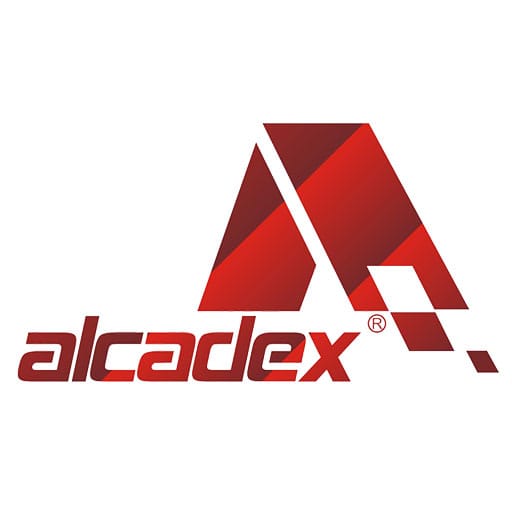
18 Jul Comparing Aluminum Cladding Types for Modern Buildings
Table of Contents
No single aluminum cladding type is ideal for every building. Each project requires different considerations such as strength, appearance, cost, and environmental impact. Builders evaluate various aluminum cladding types including solid panels, aluminum composite panels, perforated sheets, carved designs, honeycomb structures, and aluminum siding. They assess factors like durability, weight, rust resistance, design flexibility, and overall expense. Choosing the right aluminum cladding types ensures a building’s exterior remains durable and visually appealing.
Key Takeaways
Aluminum cladding helps protect buildings from bad weather. It does not rust and keeps buildings looking nice for many years. Different types of aluminum cladding have special benefits. Some are strong, some are light, and some save energy. There are many design choices too. Picking the best cladding depends on how the building is used. It also depends on the budget, weather, and design plans. Aluminum cladding saves money over time. It lowers the cost for repairs and energy. Using recycled aluminum is good for the planet. Good installation keeps buildings strong and green.
Why Choose Aluminum Cladding
Benefits for Modern Buildings
Aluminum cladding has many good points for modern buildings. Builders pick this material because it protects buildings from bad weather and does not rust. It helps buildings look nice for a long time. Many architects like aluminum cladding because it is light. This makes it easier to put on buildings and does not make the building frame heavy.
Market research says more people are using aluminum cladding. The ‘Aluminum Cladding Panel Market Report 2025-2033’ shows the market is growing fast. New technology and more demand help this growth. Builders and designers trust aluminum cladding because it works well and lasts a long time.
Some real projects show how aluminum cladding helps:
Project Name | Location | Measurable Benefits of Aluminum Cladding |
|---|---|---|
Kendeda Building | Atlanta, GA | Aluminum panels give shade and lower heat from the sun. This makes the building use less energy and keeps people comfortable. It is a green design that saves energy. |
Calgary International Airport Expansion | Calgary, Alberta | A lot of aluminum cladding was used for strength and even color. It also helps the environment. The airport is big and modern with less harm to nature. |
Aluminum cladding helps save energy by adding insulation. It can lower heating and cooling costs. This helps people save money and reach green building goals.
Key Considerations
Builders need to think about many things when picking cladding. They must look at how strong it is, if it can stop fire, and if it can handle bad weather. Aluminum cladding is good because it does not rust and needs little care.
Experts say to check the big shape, small details, and how strong the cladding is. These things show how well it will last.
How the panels are made also changes how strong they are.
Builders should look at the price, how it looks, and how it affects the environment.
Aluminum cladding follows strict safety rules, like stopping fire. This makes it a safe choice for many buildings.
Aluminum Cladding Types Overview
Solid Aluminum Panels
Solid aluminum panels are used a lot in new buildings. They are made from one sheet of aluminum. This makes them strong and tough. Builders like them because they do not rust. They also stand up to bad weather. You can use these panels inside or outside. They can be shaped and colored in many ways. This helps builders create different looks.
Aluminum Composite Panels (ACP)
Aluminum composite panels are also called acm panels or aluminum composite metal. They have two thin aluminum sheets stuck to a core. The core is made from polyethylene or mineral-filled material. ACPs are light and easy to put up. They help keep buildings warm or cool. Architects like acm panels because they come in many colors. Aluminum composite metal does not cost much and is easy to care for. ACPs are used in big buildings, signs, and curtain walls.
acm panels give you:
Good fire safety, especially with mineral cores
Quick to install and easy to keep clean
Perforated Aluminum Panels
Perforated aluminum fluted panels have small holes or shapes cut out. These holes let air and light go through. The panels still protect the building. People use them for sunshades, screens, and fancy walls. They help control sunlight and make buildings look special.
Carved Aluminum Panels
Carved aluminum fluted panels have detailed patterns cut into them. This gives the building more texture and style. Builders pick these panels for projects that need a unique look. They are strong and can handle bad weather. You can make them in many styles.
Honeycomb Aluminum Panels
Honeycomb aluminum fluted panels have two aluminum sheets and a honeycomb core. This makes them strong but still light. They are good at blocking sound and heat. Builders use them for tall buildings, ceilings, and places that need strong but light panels.
Honeycomb aluminum fluted panels are good because:
They keep out noise and heat
They are easy to move and put up
Aluminum Siding
Aluminum siding is a common type of aluminum cladding. It uses long strips of aluminum fluted panels. These strips can go sideways or up and down. Aluminum siding keeps out rain, wind, and sun. It is light, simple to install, and does not rust. Many homes and businesses use aluminum siding because it lasts a long time and needs little care. You can get it in many colors and textures, so it fits many building styles.
Tip: When picking cladding, think about what the building needs. You should look at strength, insulation, and how it looks. Aluminum fluted panels and acm panels can help with many modern designs.
Aluminum Cladding Type | Unique Features | Typical Applications |
|---|---|---|
Solid Aluminum Panels | Strong, tough, does not rust | Outside walls, inside walls, roofs |
Aluminum Composite Panels | Light, flexible, keeps heat in or out | Big walls, signs, room dividers |
Perforated Aluminum Panels | Lets air and light through, cool patterns | Sun covers, screens, fancy walls |
Carved Aluminum Panels | Special designs, custom patterns | Art walls, fancy building fronts |
Honeycomb Aluminum Panels | Strong, light, keeps out noise and heat | Tall buildings, ceilings |
Aluminum Siding | Easy to put up, protects from weather | Homes, business buildings |
Aluminum Cladding Systems and Finishes
Aluminum cladding systems keep buildings safe and make them look new. These systems use different ways to put panels on walls. Some use hidden fasteners, so the wall looks smooth. Others use fasteners you can see, which makes fixing easier. The system you pick can change how strong the panels are. It also changes how simple they are to put up.
keep buildings safe and make them look new. These systems use different ways to put panels on walls. Some use hidden fasteners, so the wall looks smooth. Others use fasteners you can see, which makes fixing easier. The system you pick can change how strong the panels are. It also changes how simple they are to put up.
Surface finishes are important for how aluminum cladding works and looks. Two common finishes are powder coating and anodizing.
Powder-Coated and Anodized Options
Powder-coated finishes cover aluminum with colored powder. Workers heat the panels, so the powder sticks tight. This finish gives bright color and stops scratches and bad weather. Powder coating lets designers choose many colors and textures.
Anodized finishes use electricity to make the surface harder. This finish helps stop rust and fading. Anodized panels often look shiny like metal. Many builders pick anodized finishes for a modern look and more protection.
Tip: Powder-coated panels are good for bright colors and special designs. Anodized panels are best for a metal look and strong protection.
Common Aluminum Grades
Aluminum cladding systems use different grades of aluminum. Each grade has its own good points. The most used grades are 3003, 5052, and 6061. The table below shows how these grades are different:
Aluminum Grade | Yield Strength (MPa) | Tensile Strength (MPa) | Corrosion Resistance | Workability | Heat Treatability | Machinability |
|---|---|---|---|---|---|---|
3003 | ~70 | 130-180 | Good | Excellent | No | Fair to Good |
5052 | ~140 | 210-290 | Excellent (marine) | Good | No | Good |
6061 | ~240 | 240-310 | Good | Good | Yes | Excellent |
Grade 3003 bends easily and is good for shaped panels. Grade 5052 does not rust, even near the sea. Grade 6061 is the strongest and can be heat treated for special jobs. Builders choose the grade that fits what their aluminum cladding systems need.
Comparing Aluminum Cladding Types

Durability and Strength
Each cladding type has its own strengths in bad weather. Solid aluminum panels and honeycomb panels use strong alloys like the 3000 and 5000 series. These alloys stop rust from saltwater, acid rain, and hot or cold weather. Special coatings, like silicone or epoxy primers, give extra protection. Builders use ventilated rainscreen systems and tough designs for more strength. Solid panels and honeycomb panels do well in strong winds and heavy rain. Aluminum siding does not rust or change shape. ACM panels stop rust and fire, so they are safe for many buildings. Perforated and carved panels are strong but may need more support in busy areas. Meeting rules for strength and fire safety keeps buildings safe in hard weather.
Weight and Installation
Weight makes a difference in how easy cladding is to put up. ACM panels and honeycomb panels are lighter than solid panels. Some aluminum siding systems weigh only 8kg per square meter. Installers can carry and fit these panels with simple tools. Aluminum siding planks weigh about 1.19kg per meter, so they are easy to move. Builders save time and work because the panels are light. Perforated and carved panels are easy to handle, but tricky shapes can slow things down. Solid panels are heavier and may need stronger frames. Honeycomb panels are strong but do not add much weight. Meeting rules for fast installation and care helps projects finish on time.
Aesthetics and Design Flexibility
Cladding types give many design choices. ACM panels come in lots of colors, textures, and finishes. Designers use them for modern styles. Perforated panels let in light and air and make cool patterns. Carved panels show detailed designs and textures, so buildings stand out. Honeycomb panels have a smooth, flat look for a clean style. Aluminum siding comes in many colors and textures for homes and businesses. Solid panels can be shaped and colored for custom looks. Builders pick the type that fits the project’s style and needs.
Cost and Value
Comparing costs helps builders choose the best cladding. The table below shows the price and value for each type:
Cladding Type | Cost Range (per m²) | Key Cost Factors | Value Highlights |
|---|---|---|---|
Aluminum Composite Panels | $20 – $60 | Lightweight core, easy installation | Lower initial cost, versatile, quick to install |
Solid Aluminum Panels | $40 – $80 | Thickness, custom textures | High durability, impact resistance |
Corrugated Aluminum Panels | $25 – $50 | Profile depth, coatings | Good for industrial use, corrosion resistance |
Perforated Aluminum Panels | $30 – $70 | Pattern complexity, size | Custom looks, light control |
Honeycomb Aluminum Panels | $50 – $120 | Core density, size, thickness | Strong, light, high-performance uses |
Aluminum siding costs less than most other types and lasts a long time. ACM panels cost about 30% less to put up than steel. Builders save money on putting up and caring for aluminum siding and ACM panels because they do not rust and need little work. Insulated panels help save on heating and cooling bills. Over time, these savings make aluminum siding and ACM panels smart picks for many projects.
Maintenance and Longevity
Aluminum siding and ACM panels last a long time with little care. If you take care of aluminum siding, it can last over fifty years. Enamel finishes keep their color for 15 to 25 years without fading. ACM panels, used since the 1960s, do not rust, swell, or shrink. They also stop bugs and fire, which helps them last longer. New ACM panels use better cores and coatings for even more strength. Honeycomb and solid panels also last long and need little care. Builders pick these types to meet tough rules for putting up and caring for cladding. Perforated and carved panels need cleaning to look good, but they do not rust. Meeting fire safety and long-life rules helps keep buildings safe for many years.
Sustainability and Environmental Impact
Life cycle checks look at every step, from getting materials to throwing them away.
Getting and making aluminum uses a lot of energy.
Greenhouse gases and fossil fuels are big worries for the environment.
Mining bauxite can cut down forests and hurt animals’ homes.
Strong panels like ACM and aluminum siding make less waste because they last longer and do not need to be replaced often.
ACM panels help save energy by adding insulation and lowering heating and cooling needs.
Aluminum siding is easy to recycle, but ACM panels need special places to take them apart.
Builders can pick recycled or responsibly made aluminum, panels with better insulation, and low VOCs for greener buildings.
Good putting up and care help panels last longer and lower harm to the environment.
A full life cycle check helps builders make better choices for the planet.
Note: Picking the right cladding depends on what the project needs for strength, care, fire safety, and saving energy. Aluminum siding and ACM panels often meet these needs and give good value and long life.
Choosing the Right Exterior Cladding
 Project Type and Use Case
Project Type and Use Case
To pick the best exterior cladding, first know what the building is for. Commercial buildings need panels that are strong and last a long time. These panels must handle lots of use and bad weather. Homes care more about how things look and easy cleaning. Aluminum cladding works for both types of buildings. Tests show aluminum panels protect against hail and other storms. This makes aluminum a good pick for schools, offices, and homes where storms happen a lot. Builders should choose the right panel type for each building’s needs.
Budget and Lifecycle Costs
Planning a budget means thinking past the first price. Aluminum cladding can cost more at first, but it saves money later. It can last up to 60 years and does not need much care. Owners spend less on fixing or replacing it. Aluminum costs less over time than vinyl or wood. Tools like Net Present Value and payback period help builders see these savings. For example, a warehouse paid more at first for better insulation but saved money in six years. These tools show aluminum is a smart choice for green building.
Aluminum cladding costs more at first but saves money later.
It lasts longer than vinyl, fiber cement, or wood.
Cost analysis tools help owners plan ahead.
Climate and Building Codes
The weather affects which cladding is best. In wet or coastal places, marine-grade aluminum does not rust or get damaged. Hot places need panels that reflect sunlight to keep buildings cool. Building codes have rules for fire safety, wind, and energy use. Aluminum cladding meets these rules and keeps buildings safe. Builders should always check local rules before picking a system.
Tip: Always check local building codes and weather before choosing.
Design and Sustainability Goals
Design goals include style and being good for the planet. Aluminum cladding comes in many colors, shapes, and finishes. It also helps the environment. Aluminum can be recycled and makes less waste. Builders can use panels with recycled parts and low-VOC coatings. Adding insulation or solar panels saves energy. Life Cycle Assessment tools help measure carbon and other effects. These choices help buildings be greener and meet eco-friendly goals.
Sustainability Metric | How Aluminum Cladding Helps |
|---|---|
Recyclability | |
Long life, fewer replacements | |
Energy Efficiency | Works with insulation, solar panels |
Low Maintenance | Needs little upkeep |
Picking the best aluminum cladding depends on what the project needs, how much money you have, and the weather where the building is. Every type has its own good points for strength, looks, and price. Builders should think about what they need, talk to experts, and use this guide to help them choose.
Industry reports get ideas from expert talks, market numbers, and world trends to make these tips.
Good research and double-checking facts help builders pick the right cladding for new buildings.
FAQ
What is the main benefit of aluminum cladding?
Aluminum cladding keeps buildings safe from rain and sun. It does not rust. It makes buildings look new and modern. Builders like it because it lasts many years. It does not need much cleaning or fixing.
Can aluminum cladding be recycled?
Yes, you can recycle aluminum cladding completely. Many builders pick recycled aluminum. This helps nature and cuts down on trash.
How does aluminum cladding handle fire safety?
Aluminum cladding does not catch fire easily. Some panels have mineral cores for more safety. Always check your local rules for fire safety.
Which aluminum cladding type is best for energy savings?
Cladding Type | Energy Savings |
|---|---|
Honeycomb Panels | High |
Composite Panels | Medium |
Solid Panels | Medium |
Honeycomb and composite panels help keep heat in or out. They make heating and cooling cost less.



 Project Type and Use Case
Project Type and Use Case